![]()
![]()
![]()
Use LEFT and RIGHT arrow keys to navigate between flashcards;
Use UP and DOWN arrow keys to flip the card;
H to show hint;
A reads text to speech;
154 Cards in this Set
- Front
- Back
|
represent units and command
posts |

A rectangle is used to
|
|
|
a staff is extended from the lower
left corner of the rectangle, at a right angle to the base. |

command post
|
|
|
triangle
|

observation or listening post
|
|
|
squad
|

Dot
|
|
|
Section (larger than a
squad, but normally smaller than a platoon. For example, a machine gun section contains 22 men |

2
|
|
|
Platoon or detachment
|

3
|
|
|
not be used in construction of
unit symbols but will be used on overlays and fire plan sketches at the small unit level- overlays and fire plan sketches |

Fire Team: Not not be used in ____ but will be used on ____ at the small unit level.
|
|
|
Company or battery
|

.
|
|
|
Battalion (or squadron in
aviation) |

.
|
|
|
Regiment (or group in
aviation) |

.
|
|
|
Brigade
|

.
|
|
|
Division or wing
|

.
|
|
|
Company
|

.
|
|
|
battalion/squadron
|

.
|
|
|
Regiment/Group
|

.
|
|
|
squad
|

.
|
|
|
Section
|

.
|
|
|
Platoon
|

.
|
|
|
Mechanized/Armored (tracked)
|

.
|
|
|
Mechanized/Armored Wheeled,cross country
|

.
|
|
|
Amphibious
|

.
|
|
|
Missile
|

.
|
|
|
Air Assault
modifier for ground units) |

.
|
|
|
Gun system
equipped (w/30mm Bushmaster, Vulcan, ZSU, etc.) |

.
|
|
|
Ski-mobile
|

.
|
|
|
Riverine
|

.
|
|
|
Attack
(modifier for aviation units) |

.
|
|
|
Infantry
|

.
|
|
|
Tank
|

.
|
|
|
Engineer
|

.
|
|
|
Air Defense
|

.
|
|
|
Maintenance
|

.
|
|
|
Helicopter
Unit |

.
|
|
|
Mechanized
Infantry |

.
|
|
|
Infantry
Mechanized in AAVs |

.
|
|
|
Motorized
Anti-Armor (CAAT) Riverine Assault Craft |

.
|
|
|
Artillery
|

.
|
|
|
Reconnaissance
|

.
|
|
|
Supply
|

.
|
|
|
Communication
|

.
|
|
|
Motor
Transport |

.
|
|
|
Anti-Armor
|

.
|
|
|
Fixed-Wing
Aviation Unit |

.
|
|
|
Assault
Amphibian Vehicle Unit (AAV) |

.
|
|
|
Light Armored
Reconnaissance (LAR) |

.
|
|
|
Riverine
Assault Craft Unit |

.
|
|
|
Motorized
Stinger (Anti-Air) Unit |

.
|
|
|
Air Assault
Infantry |

.
|
|
|
Attack
Helicopter |

.
|
|
|
Fixed-Wing
Attack Aviation |

.
|
|
|
Marine Air Ground Task Force
|

.
|
|
|
Marine Expeditionary Unit
(MEU) |

.
|
|
|
Marine Expeditionary Force
(MEF) |

.
|
|
|
If a unit is temporarily organized or "task-organized" for
a specific operation, into a task force or company team, a "hood" is placed over the size indicator. |

When used, (±) symbols are not used.
|
|
|
Company Team: Controlled by the tank commander
|

.
|
|
|
Battalion Task Force: Commanded by the infantry
|

.
|
|
|
Basis Enemy Unit
|

.
|
|
|
Enemy Artillery Battery
|

.
|
|
|
Enemy rifle squad
|

.
|
|
|
Enemy Rifle
Company |

.
|
|
|
Basic weapon
symbol (light) |

.
|
|
|
Basic weapon
symbol (medium) |

.
|
|
|
Basic weapon
symbol (heavy) |

.
|
|
|
Light
rifle/automatic weapon |

.
|
|
|
Medium
rifle/automatic weapon |

.
|
|
|
Heavy
rifle/automatic weapon |

.
|
|
|
Antitank
|

.
|
|
|
Rocket
|

.
|
|
|
Indirect fire/high
trajectory |

.
|
|
|
Direct fire gun
|

.
|
|
|
Anti-air/air
defense |

.
|
|
|
Surface-tosurface
missile |

.
|
|
|
Track selfpropelled
|

.
|
|
|
Wheeled (limited
cross-country) |

.
|
|
|
Wheeled (crosscountry)
|

.
|
|
|
Wheeled (crosscountry)
armorprotected |

.
|
|
|
Amphibious
|

.
|
|
|
Over-snow
|

.
|
|
|
Tank
|

.
|
|
|
Infantry fighting
vehicle |

.
|
|
|
Limited crosscountry
cargo/personnel carrier (e.g. 5-ton; HMMWV) |

.
|
|
|
60mm mortar
|

.
|
|
|
81mm mortar
|

.
|
|
|
120mm mortar
|

.
|
|
|
AT-4 84mm
antitank rocket |

.
|
|
|
83mm SMAW
|

.
|
|
|
Stinger anti-air
missile |

.
|
|
|
M203 grenade
launcher |

.
|
|
|
Mk-19 grenade
launcher |

.
|
|
|
LAV-25
|

.
|
|
|
Javelin Anti-Tank
Missile |

.
|
|
|
TOW antitank
missile |

.
|
|
|
M40A1 7.62mm
sniper rifle |

.
|
|
|
SASR .50 cal
sniper rifle |

.
|
|
|
105mm howitzer
|

.
|
|
|
155mm howitzer
|

.
|
|
|
Fixed-wing
attack aircraft |

.
|
|
|
Attack helicopter
(Cobra) |

.
|
|
|
Heavy-lift assault
helicopter (CH-53) |

.
|
|
|
Medium-lift
assault helicopter (CH- 46) |

.
|
|
|
Assault
amphibious vehicle (AAV) |

.
|
|
|
M1A1 tank (the
three vertical lines identify this as a “heavy” tank) |

.
|
|
|
Strong point
|

.
|
|
|
Antitank Ditch (top of
triangles is toward enemy) |

.
|
|
|
Fortified line
|

.
|
|
|
Roadblock, completed
|

.
|
|
|
Unspecified wire obstacle
|

.
|
|
|
Single strand concertina
|

.
|
|
|
Antitank minefield
|

.
|
|
|
Booby trap
|

.
|
|
|
Non-headquarters units
|

.
|
|
|
Headquarters unit
|

.
|
|
|
A future or projected location for a unit is identified using a
broken/dashed line: |

.
|
|
|
Groups of non-headquarters
units |

.
|
|
|
Groups of headquarters
units |

.
|
|
|
An assembly area is the area where a unit assembles to
prepare for further action. Assembly areas are enclosed with a solid line and the unit symbol is placed inside the circle. The CP symbol may be used if the CP location is known. A future or proposed assembly area is shown with a broken line. For example, here is the representation for an assembly area occupied by 2d Bn, 9th Marines: |
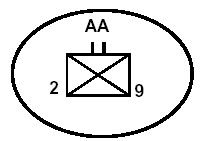
.
|
|
|
Assault position: Co K, 3d
Bn, 6th Mar |
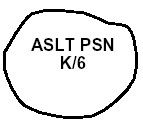
.
|
|
|
Company battle
position |

.
|
|
|
Battle position,
Company K |

.
|
|
|
the boundary separating 1st Marine Division from 2d
Marines |
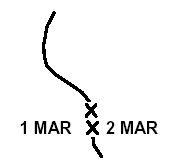
.
|
|
|
Advance
The axis of advance indicates a general direction of movement for a unit. A commander assigned an axis of advance may deviate from the axis; however, a major deviation must be reported. It is labeled with a code name, letter, or unit designation. |

.
|
|
|
The airborne axis of advance is the same as a ground axis of advance
except it has a twist in the shaft of the open arrow. |

.
|
|
|
A passage point is a location in which one unit passes
through another unit that is in contact with the enemy or a location where a unit withdraws through another unit occupying rearward positions. It will be labeled with a number or letter for identification. |

.
|
|
|
A linkup point is a point at which two converging friendly
forces make physical contact. The point should be mutually agreed upon and should be readily recognizable by both forces. |

.
|
|
|
Point
A contact point is a location where two or more units are required to make physical contact. It is a square with a number placed inside. |

.
|
|
|
A phase line is used for the control of forward movement
and coordination of units. It should be extended across the entire zone or sector, preferably along an easily identifiable terrain feature or man-made object. It is labeled with a code name, letter, or number for identification. |

.
|
|
|
A coordinating point is a designated point at which, in all types of combat, adjacent units/formations must make
contact for purposes of control and coordination. |

.
|
|
|
A restrictive fire line is a line established between converging friendly forces (one or both may be moving) that prohibits fires or the effect of fires across the line without coordination with the affected force.
|

Restrictive
Fire Line (RFL) |
|
|
Zone of Action
A zone of action is a tactical subdivision of a larger area, the responsibility of which is assigned to a tactical unit, generally applied to offensive combat. Zones of action assigned to subordinate units prevent interference among units operating in adjacent areas. At platoon and squad levels, the zone of action is frequently expressed as a frontage. At company level and above, zone of action is normally defined by a line of departure, an objective (or objectives), and a boundary on one or both flanks. |
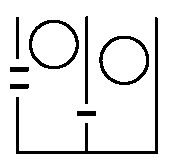
.
|
|
|
Point Target
A point target is a target of such small dimension that it requires the accurate placement of ordnance to neutralize or destroy it. |

.
|
|
|
Linear Target
A linear target is a target whose length is • More than 200 meters • Less the 600 meters Targets longer than 600 meters will require fire support other than indirect fire or may be subdivided into multiple targets for attack with indirect fire. A linear target is designated on the target list or list of targets by • Two grids • A center grid, length, and attitude |

.
|
|
|
Rectangular Target
A rectangular target is a target wider and longer than 200 meters. It is designated on the target list or list of targets by • Four grids • A center grid, length, width, and attitude |

.
|
|
|
Circular Target
A circular target is circular in nature or is vague as to its exact shape. It is designated by a center grid and a radius on the target list or list of targets. |

.
|
|
|
Group of Targets
A group is two or more targets that are attacked simultaneously. Groups give the maneuver commander the ability to hit different enemy positions at the same time without having to request individual targets. A group of targets is designated by an alpha/numeric combination. It is depicted on a map as in the example below. |

.
|
|
|
Final Protective Fire (FPF)
The FPF is normally drawn to scale as a linear target. The symbol used includes the • Target number • Designator of FPF • System/unit to deliver the fires |

.
|
|
|
Target Reference Point (TRP)
Maneuver elements use an easily identifiable TRP to orient direct-fire weapons systems. TRPs should be dually identified in terms of the direct-fire system and the target numbering system. The symbol is the same as that for a standard target with a target number and TRP letter. Only essential TRPs are integrated into the fire plan. |
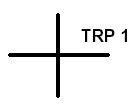
.
|
|
|
Operational symbols are effective mediums of
communication because when properly employed they are |
clear, concise, and uniform.
|
|
|
Operational symbols are used on
|
operational graphics,
situation maps, and overlays. |
|
|
The key to constructing or interpreting operational
symbols comes from the knowledge of the |
organization of
the Marine Corps. |
|
|
1st Marine
Division |
• 1st, 5th, and 7th Marine Infantry Regiments
• 11th Marine Artillery Regiment |
|
|
2d Marine
Division |
• 2d, 6th, and 8th Marine Infantry Regiments
• l0th Marine Artillery Regiment |
|
|
3d Marine
Division |
• 3d and 4th Marine Infantry Regiments
• l2th Marine Artillery Regiment |
|
|
4th Marine
Division |
• Is a reserve division
• 23d, 24th, and 25th Marine Infantry Regiments • l4th Marine Artillery Regiment • 9th Marine Regiment was cadred in 1994 |
|
|
Companies D, H, and M are contingency units
|
to be
manned on special directive only. |
|
|
Role indicator symbols describe
|
the basic role or mission of
the unit. Combined with size indicators and any applicable unit symbol modifiers (discussed previously in this text), a detailed and informative symbol is created. |
|
|
friendly units and/or equipment
|
Blue
|
|
|
enemy units and/or equipment (diamond shape
or “ENY” if only one color is used) |
Red
|
|
|
unknown or pending identification
|
Yellow
|
|
|
neutral forces and all obstacles whether
friendly, enemy, or neutral |
Green
|
|
|
all friendly control measures; used as the single
color for all graphics if colors above are not available |
Black
|
|
|
An overlay can be used to make changes in unit
|
• Positions
• Weapons • Movements |
|
|
A legend must only be added when
|
nonstandard symbols are used.
|
|
|
Targets longer than ___ will require fire support other than indirect fire or may be subdivided into multiple targets for attack with indirect fire.
|
600 meters
|
|
|
The difference in rectangular symbol for a barrage and an area target is the ___. That is, an area target will
have a regular target designation, and a barrage will show the unit designated to fire that particular barrage. |
numbering
|

